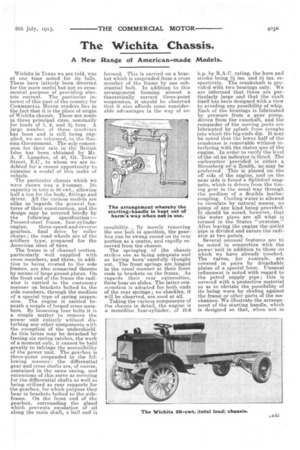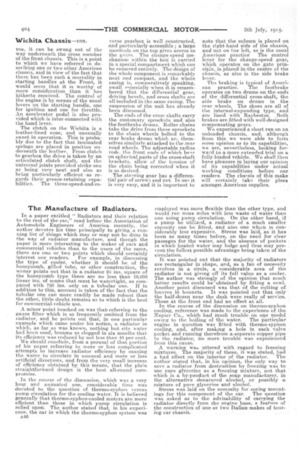The Wichita Chassis.
Page 17

Page 18

If you've noticed an error in this article please click here to report it so we can fix it.
A New Range o! American-made Models.
NVichita in Texas we are told, was at one time noted for its falls. These have latterly been diverted for the more useful but not so ornamental purpose of providing electric current. The particular interest of this part of the country for COMMERCIAL MOTOR readers lies in the fact that it is the place of origin of Wichita chassis. These are made in three principal sizes, nominally for loads of 1, 2, and 3i tons. A large number of these machines has been and is still being supplied, we are informed, to the Russian Government. The sole concession for their sale in the British Isles has been obtained by Mr. A. F. Langdon, of 40, Gt. Tower Street, KO., to whom we are indebted for a recent opportunity to examine a model of this Make of vehicle.
The particular chassis which we were shown was a 2-tonner, its capacity in tote is 50 cwt., allowing half a ton for the body, fittings and driver. All the various models are alike as 'regards the general features of their construction, and the design may be covered briefly by the following specification:— Pressed-steel frame, four-cylinder
engine, three-speed-and-reverse gearbox, final drive by roller chains ; the road wheels are of the artillery type; prepared for the American sizes of tires.
The frame is of channel section, particularly well supplied with cross members, and these, in addition to being riveted to the side frames, are also connected thereto by means of large gusset plates. On the front end of the frame the radiator is carried in the customary manner on brackets bolted to the side members, through the medium of a special type of spring suspension. The engine is carried beneath a couple of Forged cross members. By loosening four bolts it is a simple matter to remove the power unit entirely without disturbing any other components with the exception of the undershield. As this latter may be detached by freeing six spring catches, the work of a moment only, it cannot be held greatly to infringe the accessibility of the power unit. The gearbox is three-point suspended in the following manner : the differential gear and crass shafts are, of course, Contained in the same easing, and extensions of this serve as covering for the differential shafts as well as being utilized as rear supports for the gearbox, for which purpose they bear in brackets bolted to the sideframe. On the front end of the, gearbox, surrounding the gland which prevents exudation of oil along the main shaft, a ball end is
formed. This is carried on a bracket which is suspended from a cross member of the frame by one substantial bolt. In addition to this arrangement forming almost . theoretically correct three-point suspension, it should be observed that it also affords some considerable advantages in the way of ac cessibility. „ By merely removing the one bolt in queStion, the gearbox can be swung round on its rear portion as a centre, and rapidly removed from the chassis.
The springing of the chassis strikes one as being adequate and as having been carefully -thought out. The front springs are hinged in the usual manner at their front ends to brackets on the frame. As regards their rear extremities, these bear on slides. The latter construction is adopted for both ends of the rear springs ; no shackles, it will be observed, are used at all. Taking the various components of the chassis in detail, the engine is a monehloc four-cylinder, of 19.6 h.p. by R.A.C. rating, the bore and
stroke being ai ins, and ins. respectively. The crankshaft is provided with two bearings only. We are informed that these are particularly large and that the shaft itself has been designed with a view to avoiding any possibility of whip. Each of the bearings is lubricated by pressure from a gear pump, driven fram the camshaft, and the remainder of the moving parts are lubricated by splash from troughs into which the big-ends dip. It may be.noted that the lower half of the crankcase is removable witheut interfering With the status' nil° Of the :engine. In order to verify the level Of the oil an indicator is fitted. The' carburetter 'provided is either a Strombeig er".21; Zenith, as' May be preferred. This is placed tin the off side of the engine; and on the near Side i•s found a Splitdarf magneto, which is driven from the timing gear in the usual way through the medium of a flexible leather coupling. Cooling water is allowed to circulate by natural means, no pump of any kind being presided. It should be noted, however, that the water pipesare all what is termed in the States. "eversize." After leaving the engine the Outlet pipe is divided and enters -the'radi. at-or at two points. • • Several unusual feature S are to . be noted in connection .With the power 'unit in addition to these On which we have already • tonched, The valves, for example, are coVered in pairs by detachable Plates of a special form. Unusual refinement is noted with regard to the petrol supply pipe ; this is covered with a protective material so as to obviate the possibility of its being warn by chafing against the frame or other parts of the mechanism. We illustrate the arrangement of the starting handle, which is designed so that, when not in
use, it can be swung out of the way underneath the cross member of the front chassis. This is a point to which we have referred in describing one or two other American chassis, and in view of the fact that there has been such a mortality in starting handles at the Front, it would seem that it is worthy of more consideration than it has hitherto received. The control of the engine is by means of the usual levers on the starting handle, one for ignition and one for throttle. An accelerator pedal is also provided which is inter-connected with the hand lever.
The clutch on the Wichita is a leather-lined cone, and unusually sweet in operation. This is probably due to the fact that laminated springs are placed in position underneath the leather. From clutch to gearbox the drive is taken by an articulated clutch shaft, and the universal joints provided strike one as being very neat and also as being particularly efficient as regards their grease-retaining capabilities. The three-speed-and-re verse gearbox is well constructed, and particularly accessible ; a large nandhole on the top gives access to the gears. The change-speed mechanism within the bo-x is parried in a special compartment which can be removed entirely. The design of the whole component is remarkably neat and compact, and the whole casing is, comparatively speaking, small especially .when Ads tremernbereti that the differential gear, driving bevels, and cross shafts are all included in. the same casing. The suspension of the unit has already been discussed.
The ends of the cross shafts carry the customary sprockets and also the footlarake drums. Roller chains take the drive from these sprockets to the chain wheels bolted to the rear brake drums which are themselves similarly attached to the rear road wheels. The adjustable radius rods. the front ends of which bear on spherical parts of the cross-shaft brackets, allow of the tension of the chain being corrected when it is so desired.
The steering gear has a differential pair of screws and nut. In use it is very easy, and it is important to
note that the column is placed on the right-hand side of the chassis, and not on the left, as is the usual American practic6 The control lever for the change-speed gear, Which operates on the gate winciVe, ia.placed-in the centre cf the chassis, as also is the side brake lever.
The braking is typical of American practice. The footbrake operates on two drums on the ends of the differential cross-shaft, the side brake on drums in the rear wheels. The shoes are all of the internal-expanding type, and are lined with Baybestos. Both brakes are fitted withwell-designed compensating gears.
We experienced a short run on an unloaded chassis, and, although h011k this we were able to form some opinion as to its capabilities, we are, nevertheless, looking forwad to to a more extended trial on a fully-loaded vehicle. We shall then have pleasure in laying our opinion of its capabilities under actual working conditions before our readers. The chassis of this make will certainly take their place amongst American supplies.






















